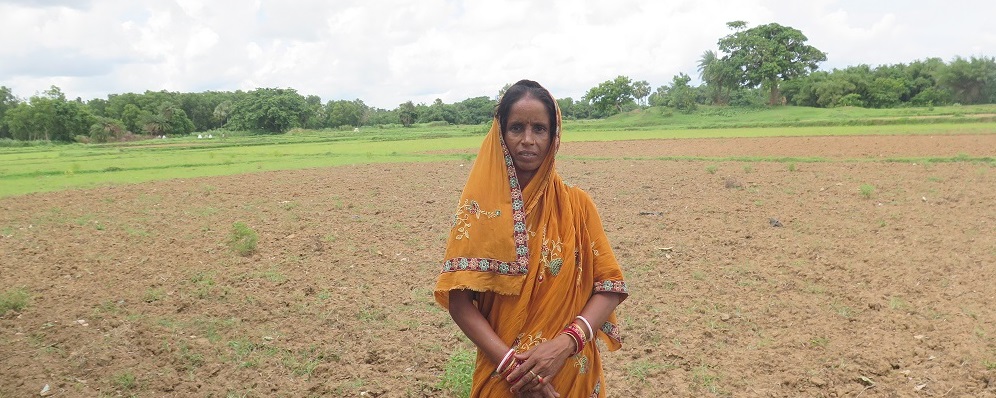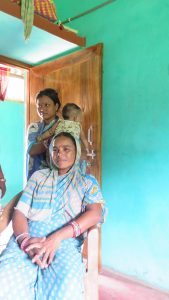An update on three women farmers in India who were successful in their quest to rewrite their destiny.

Sukanti Swain, the “Leader,” has become the go-to person in their village for the implementation of any government program. (Photo by Sam Mohanty)
In 2013, we wrote about Sukanti Swain, Sanjukta Naik, and Rabi Pradhan in the eastern Indian state of Odisha (See Breaking the barriers: from housewives to breadwinners). They overcame social obstacles and transitioned from being stay-at-home wives and mothers to being successful farmers, entrepreneurs, leaders, motivators and role models. In this piece, we nicknamed Sukanti Swain the “Leader,” Sanjukta Naik the “Machine,” and Rabi Pradhan the “Fighter.”
Nearly three years later, we went back to meet our three real-life heroes to get an update on their situation. Our first stop was at Sukanti Swain’s house.
The leader’s success
The “Leader” greeted us with a big smile. Her house is much improved now with a few new appliances inside. Like before, she owns only 0.3 hectare of farm land and share-crops on an additional 2 hectares. She has been growing paddy in the kharif season and, after paddy harvest, she has been shifting from mungbean to sunflower for the last two years because of the government subsidy for seed and fertilizer and for higher profitability. She also manages a small grocery store in the village and serves as the secretary of a self-help group (SHG) she founded a decade ago. In addition, she serves as the community resource person for 12 other SHGs in the nearby villages.
She continues to help her husband with his pakhundi business (making fences using bamboo sticks and using coconut leaves for growing betel plants). In terms of asset creation, she purchased a power tiller using part of a loan from her SHG. She also plans to purchase a mechanical thresher to expand her custom hiring business.
Overall, her economic condition has improved significantly since our last visit. She credits her SHG for giving her a loan for purchasing a power tiller and expanding her husband’s pakhundi business. She estimated her average monthly income from all sources (farming, SHG involvement for government program implementation, among others) to be around USD 600. Apart from the monetary benefits, she also enjoys the high social status she has earned over the years and she has become a role model for many other young women in the village council, locally known as the panchayat.
However, what got our attention was her image and stature as a leader and the value of her services. She has become the go-to person in the panchayat for the implementation of any government program. Government agencies keep her on a retainer for rolling out new programs. Using her as a reference helps needy villagers successfully obtain loans at the local bank.
She has convinced hundreds of women in the panchayat to join an SHG and save money on a weekly basis. In her panchayat, the number of SHGs has increased from 70 to 98. All the women in the panchayat above 18 years old are members of an SHG, including newly-wed daughters-inlaw. This is in stark contrast to the time of her initial involvement in the SHG when women were not allowed to go outside the house and attend meetings, according to Sukanti.

Rabi Pradhan, the “Fighter,” trained her sister-in-law and a few other women in the village in growing betel leaf. (Photo by Sam Mohanty)
The Machine and the Fighter settle down
After Sukanti, we met our other two heroes: Sanjukta and Rabi. Although both are doing well, we didn’t see the same fire and drive they had three years ago.
Sanjukta’s work habit had earned her the nickname the “Machine.” She still grows paddy but on less than 1 hectare of land compared with the 1.4 hectares three years ago. She does a few other things to earn additional income (garlic processing and livestock). Both her daughters are married and her son, after dropping out of high school, now works in a textile mill in Gujarat. Sanjukta’s husband has returned to the village to farm.
She still works as the secretary of an SHG. She has a monthly income of USD 375 from all sources, including her husband and son. She still contributes a large share to the family income pool.
Her shattered dream of making her son, who dropped out of school, become a police officer seems to have affected her work drive. She still wants her son to return to high school and complete his education and become a police officer.

Sanjukta Naik, the “Machine,” shifted her priorities toward taking care of her family and grandchildren but still contributes a large share to the family income pool. (Photo by Sam Mohanty)
Similarly, Rabi Pradhan, the “Fighter,” has also slowed down in her daily struggle of raising three children after her husband abandoned them a few years ago. Her two daughters are now married and her son works as a mechanic in a nearby town. She has given up her betel leaf plantation but she trained her sister-in-law and a few other women in the village in growing betel leaf. She still grows paddy on 0.67 hectare of share cropping, primarily for consumption and she occasionally sells some if they have a surplus.
After the marriage of their daughters, the Machine and the Fighter have slowed down a bit on the work front and their priorities have shifted toward taking care of their respective families and grandchildren. However, all this has been possible only because of the hard work they had put in during the previous years. It was pleasing to see that their financial stability has given them an option of choosing a work-home balance, which was not available to them in the past and is not available to many other women in the village.
Spreading success
Sukanti Swain, Sanjukta Naik, and Rabi Pradhan were married to marginal farmers with less than half a hectare of landholding. They were expected to play the role of traditional housewives in their homes. But, apart from fulfilling their responsibilities as housewives, they have emerged as primary earning members of the family and have become role models for other women and young girls in their villages. Their successes have been so contagious that all the women— old and young—in the panchayat have joined SHGs. Thanks to the Leader, the Machine, and the Fighter, many women are now actively managing farms and pursuing other activities for supplemental income.
________________
Dr. Mohanty is the head of the Social Sciences Division (SSD) and program leader (targeting and policy) at the International Rice Research Institute (IRRI). Dr. Mohapatra is an assistant scientist and Ms. Baruah is a PhD scholar in SSD.







